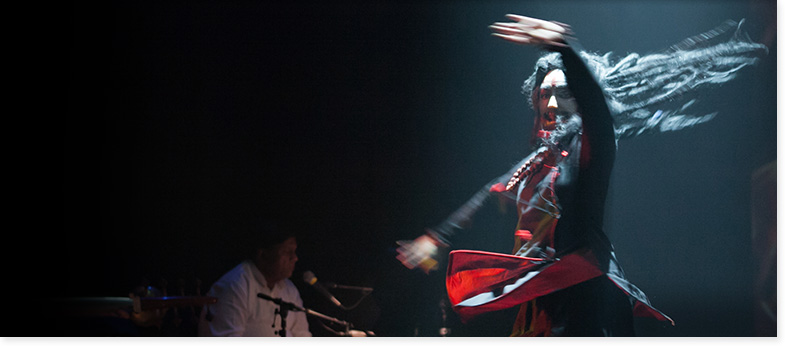
INDIA’S KATHAK DANCE
In Troupe’s Posthumous Tribute to Chitresh Das
BERKELEY—The idea of “modern” Indian dance is perhaps difficult for many spectators to grasp, because the concept of “Indian” dance has become so intensely associated with a notion or memory of India from a pre-modern era. Indian dance means for the most part preserving “traditions” from pre-modern times rather than breaking with them. Teacher and choreographer Pandit Chitresh Das (1944-2015) exemplified throughout his life an inclination to adapt traditional Indian dance forms, particularly the Kathak style, to a modernist temperament.
The company he founded, Chitresh Das Dance, was at Zellerbach Hall on February 27th and 28th for concerts to honor his achievements. The “Shiva” concert on Saturday began with a sung dedication by numerous Panditji students, who filled the stage and as well as the aisles of the theater. A brief video followed, showing the master and his disciples discussing his achievements. Only then Shiva, the last piece choreographed and staged by the master, could begin.
The piece is about a spiritual journey of a devotee of the Divine, split into three parts: Devotion, Distraction and Redemption, each part first spoken aloud and sometimes accompanied by screen titles, so that even those who have not read the program notes could understand the story without difficulties, followed by the musical and danced performance of the events. The dance ensemble consisted of thirteen dancers accompanied by seven musicians who were on stage and often as entertaining as the dancers, particularly the tabla drummer Satyaprakash Mishra. Shiva also makes use of video projections, which mostly consist of haunting, fog-enshrouded or moonlit scenes of Himalayan mountain peaks, these being the remote abodes of Shiva. But the piece also skillfully uses silhouette shadow projections of Shiva dancing alone or with worshipers.
As might be expected of the master of an established tradition, the piece displayed its conventions and the innovations within it adeptly and with subtlety. The length of the piece – about 90 minutes without an intermission (plus about half an hour of the dedication) – is a precarious balance between long traditional events and modern bustling lifestyles, the tempo of the piece and changes of scenes are faster than is “normal” to the tradition but much slower than the action-filled entertainment world usually allows. The tradition, just like a great deal of post-modern performance, emphasizes repetition with minimal changes with the idea of carrying the audience into a trance-like state. However, when one is not fully captivated by what is happening on stage, these reiterations tend to become somewhat tedious, even if you admire the complex rhythms released by the instruments under the skillful hands of the musicians or by the fast feet of the dancers stamping and whirling around. The movement vocabulary does remain limited. The trance-oriented aesthetic emphasizes a lot of whirling, a lot of upward thrusting arms, a lot of undulant arms, a lot of foot-pounding, a lot of unison ensemble movement, and a lot of one half of an ensemble echoing the movement of the other half. This kind of aesthetic does not allow for much, if any, drama, conflict, or tensions between dancers or within groups. But this mode of dance is not really keen on emotional engagement—the focus is on spiritual experience, which is inevitably a release from “attachments” to the bodies and identities that generate emotional investment. The dancers rarely touch each other. An interesting feature of the dance is that all of the musicians are male and all of the dancers are female. But about half of the women appear as men, ascetic followers of Shiva, wearing beards, long, matted hair, and monkish clothes. The dancers do not wear the sort of rich, “colorful” costumes usually seen in Indian dance, but the costumes, by an unidentified designer, are nevertheless soberly effective, as is the lighting, which relies heavily on a variety of spotlight and fog configurations.
The shadow-theater scenes were among the most captivating: Shiva was only visible as a shadow image, and the scene of the deity Madan sending his (invisible) arrow of love towards Shiva and the latter’s rage and subsequent burning of Madan to death was exciting. A couple of other intriguing scenes involve the ascetics and their guru dancing with human skulls. The piece also includes an extensive female solo dance, a romantic pair dance, and a scene in which a pair of females attempt to seduce the guru. But these were perhaps not so modern as the spectacle of young women, impersonating older men, dancing with skulls, under the shadow-image of Shiva or the Himalayan mountains.
“Shiva” seems to belong to a category of performances that caters to its audience’s spiritual rather than aesthetic needs by offering a cherished way of living in the present climate of relative values and rapidly changing conditions of existence. However, traditions can stay alive only when they are modified, and this is clearly what Pandit Chitresh Das aimed to do by using what is essentially a solo dance form (Kathak) as a means of a group choreography, and by applying modern story telling technology in relation to a traditional narrative. Devotion takes many forms, of which dancing may be a powerful one, although more so to the practitioner than to its witness.
The schools and outreach programs for Kathak dance established by Pandit Chitresh Das appear to be thriving (this one based in San Francisco). But the question remains as to whether the semi-professional dance company he founded can also thrive without his charismatic personality and without the modernist sensibility with which he infused the company. It’s not clear when or where its next performance is.
For more information, go online.
© Karl Toepfer 2016
#
Karl Toepfer is a dance reviewer for artssf.com.
These critiques appearing weekly (or sometimes semi-weekly, but never weakly)focus on theater, dance and new musical creativity in performance, with forays into recordings by local artists, and a few departures into books (by authors of the region)as well.
#